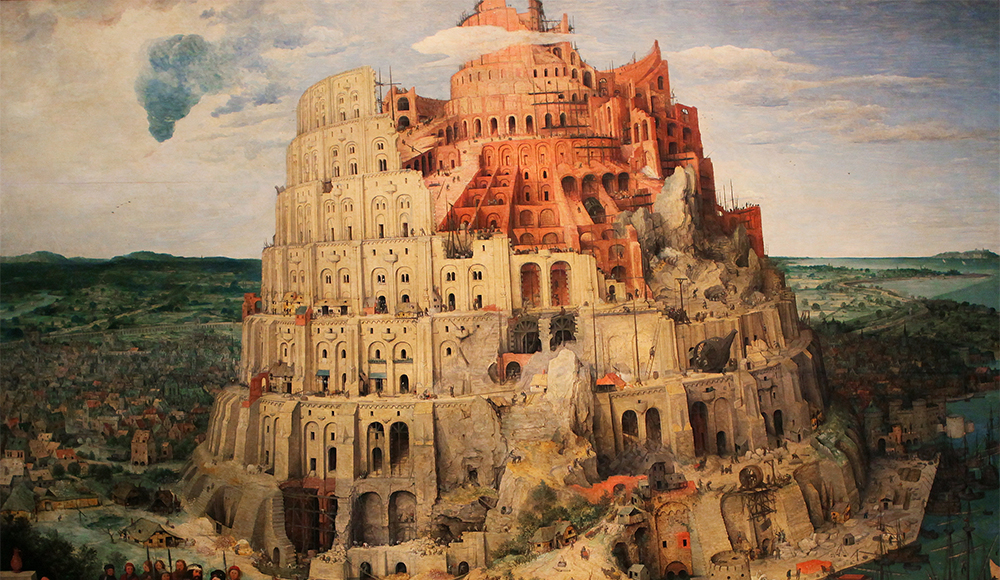Could the Tower of Babel Have Been in Yemen?
Genesis 11 relates the story of Noah’s descendants after the ark grounded:
And it came about, as they journeyed east, they found a plain in the land of Shinar and settled there. And they said to one another, “Come, let us make bricks and fire them thoroughly [śâraph śerêphâh].” And they used brick for stone, and they used tar for mortar. And they said, “Come, let us build for ourselves a city, and a tower [migdâl] whose top will reach into heaven” (Genesis 11:2–4a, NASB, emphasis original).
Mud Bricks or Fired Bricks?
Scholarly opinion generally associates Shinar with Mesopotamia (modern Iraq), and the Tower of Babel with a Mesopotamian ziggurat such as Babylon’s Etemenanki, which stood during the Babylonian exile of the Jewish people.1 Yet there are technical problems with assuming the Tower of Babel was a ziggurat:
- Ziggurats were made of mud brick reinforced with a baked brick exterior. By contrast, the Bible states the Tower of Babel was built with fired bricks, which is a complex technology. In an ancient Mesopotamian myth, the god Marduk instructs that a tower be built of “molded bricks,”2 suggesting unfamiliarity with fired brick construction. In fact, “virtually nothing is known archaeologically of brick kilns in ancient Mesopotamia.”3 It was not until “the Uruk period . . . [that] for the first time, bricks were baked in kilns” in Mesopotamia;4 the Tower of Babel existed well before the Uruk period.
- Ziggurats have few (if any) internal chambers. By contrast, the tower is described by the Hebrew word migdâl, which the Bible uses 49 times to refer to structures with interior access, such as defensive towers and watchtowers. This is echoed by the Septuagint (LXX), a translation of the Hebrew Bible into Greek by Jewish scholars in the third century BC. The LXX translators seemed to recognize the Tower of Babel was not a Mesopotamian ziggurat when they rendered migdâl in Genesis 11:4 as πύργος (pýrgos), meaning “a fortified structure rising to a considerable height, to repel a hostile attack.” Both the Hebrew and the Greek thus describe the Tower of Babel as like a modern skyscraper—not a ziggurat.
Is there a place in the ancient near east with a long history of fired brick “skyscrapers”—and for added measure, an ancient Noahic tradition? Indeed, there is: Yemen!
Yemen’s Connection to Genesis
Today war-torn Yemen is one of the most desolate, impoverished places on Earth. Yet Yemen claims to be the cradle of civilization and the birthplace of Arabs.5 Its location in the southeast corner of the Arabian Peninsula, bordering the Red Sea and the Gulf of Aden, “lies within the climatic zone of the Indian Ocean monsoons, which yield enough rainfall to make it potentially the most fertile part of Arabia. In Yemen, sophisticated irrigation techniques go very far back . . . at least [to] 2000 BCE.”6
More than three millennia ago, Yemen had a thriving civilization. Andrew Lawler notes, “By 1200 B.C.E., the kingdom of Saba in what is now central Yemen controlled the export of frankincense,” producing “vast wealth.”7 Biblical scholar Kenneth Kitchen dates the kingdom to “at least the eleventh century” BC, and states the “Hebrew Sheba is universally admitted to be the same name as the place-name commonly translated ‘Saba.’”8 The kingdom of Saba endured until 275 BC, so the queen of Sheba who visited King Solomon “carrying spices and very much gold and precious stones” (1 Kings 10:2, NASB) in the tenth century BC was probably a Sabaean monarch on a trade mission.
Consider Yemen’s Noahic traditions in the context of what may have been a fertile land long ago. Encyclopedia Britannica describes Sana’a, Yemen’s capital city, as “one of the oldest continuously inhabited cities in the world.” Furthermore, “according to Yemeni legend, it was founded by Shem, one of the three sons of Noah.”9 Genesis 10:21–31 confirms that Shem’s descendants settled Yemen.
Yemen also has a long tradition of kiln-fired mud brick towers which conform to the Genesis 11 description of the Tower of Babel. The Old City of Sanaa is designated a UNESCO World Heritage site because it “is defined by an extraordinary density of rammed earth and burnt brick towers rising several stories.”10 (A 2016 Reuters article features photos of modern brickmaking in Yemen, including both sun-drying and kiln-firing processes.)
Elsewhere in Yemen, the city of Shibam, dubbed “the Manhattan of the desert,” contains approximately 500 ancient fired-brick buildings up to ten stories high.11 As in Sanaa, the fired brick construction continues to this day: “A visitor will notice many lime kilns as well as fields of mud bricks drying in the sun.”12 Although the present high-rise structures date back only to the sixteenth century AD, the current city was built upon the ruins of an older city destroyed around AD 300.
Affirming the Genesis Account
What do we conclude? Yemen has an ancient tradition of fired-brick high-rise buildings. These structures qualify as migdâl (or pýrgos) as described in Genesis 11 for the Tower of Babel. Furthermore, the Noahic tradition of Yemen ought not be dismissed arbitrarily.
By contrast, although it is generally believed that Shinar was in Mesopotamia, ziggurats do not fit the Genesis 11 description, and the region lacks an ancient tradition of fired brick structures.
Can such dichotomy be rationalized? The regions are separated by about 2,000 miles!
The British-Yemeni Society offers a possible explanation. They find archaeological evidence for the sudden emergence of a relatively advanced civilization in Yemen, and suggest this might be due to “the arrival of new people from the areas of the Fertile Crescent to the north, and bringing with them their advanced culture.”13
Thus, a plausible scenario emerges. Suppose a fired brick Tower of Babel was indeed built in Mesopotamia, but its architects and engineers were descendants of Shem who relocated to Yemen – a relocation confirmed by both Genesis 10:21–31, 11:8 and Yemeni tradition. Expertise in this complex technology might well have been tightly held within a single, extended family; and the art of fired-brick high-rise structures was lost to Mesopotamia when this family left, but it was carried to Yemen.
Therefore, the Tower of Babel was not in Yemen, but its engineers may have moved there and took their fired brick technology with them. If this scenario is true, it seems to offer additional credibility and support for the biblical narrative:
- It provides evidence that the Tower of Babel could in fact have been built using the fired brick technology described in Genesis 11. The tower was not necessarily a mud-and-baked brick ziggurat.
- It confirms the dispersion of the builders of the tower as described in Genesis 10 and 11.
This seems to provide more evidence of the truth and accuracy of Bible—even in the minor details!
ENDNOTES
- Andrew George, “The Tower of Babel: Archaeology, History and Cuneiform Texts,” Archiv für Orientforschung 51 (January 2005): 75–95; available at .
- Kenneth A. Matthews, Genesis 1–11:26: An Exegetical and Theological Exposition of Holy Scripture, vol. 1A, New American Commentary (Nashville: Broadman and Holman, 1996), 471.
- Kadim Hasson Hnaihen, “The Appearance of Bricks in Ancient Mesopotamia,” Athens Journal of History 6, no. 1 (January 2020): 73–96, doi: 30958/ajhis.6-1-4.
- R. S. Moorey, Ancient Mesopotamian Materials and Industries: The Archaeological Evidence (Oxford: Oxford University Press, 1994), 307.
- [SEE NOTE FOR NEW CITATION NEEDED HERE.]
- Encyclopedia Britannica Online, s.v. “History of Arabia,” by Mahmud Ali Ghul et al., accessed November 28, 2020, https://www.britannica.com/topic/history-of-Arabia-31558.
- Andrew Lawler, “War Savages Ancient Sites in Yemen and Iraq, Destroying Archaeological Record,” Science, April 10, 2018, https://www.sciencemag.org/news/2018/04/war-savages-ancient-sites-yemen-and-iraq-destroying-archaeological-record.
- A. Kitchen, On the Reliability of the Old Testament (Grand Rapids, MI: William B. Eerdmans, 2003), 116, 594.
- Encyclopedia Britannica Online, s.v. “Sana’a,” accessed November 28, 2020, https://www.britannica.com/place/Sana’a.
- “Old City of Sana’a,” UNESCO, accessed November 28, 2020, https://whc.unesco.org/en/list/385.
- Finn MacLeod, “This 2,000-Year-Old City in Yemen Is Known as the ‘Manhattan of the Desert,’” Business Insider, August 5, 2015, https://www.businessinsider.com/the-manhattan-of-the-desert-shibam-yemen-2015-8.
- Howard Meadowcroft, “Mud Brick Architecture of Yemen,” Global Dispatches (website), September 2, 2018, http://www.theglobaldispatches.com/articles/mud-brick-architecture-of-yemen.
- Phillips, “Archaeological Research in Yemen,” British-Yemeni Society (November 1996), http://al-bab.com/albab-orig/albab/bys/articles/phillips96.htm.






